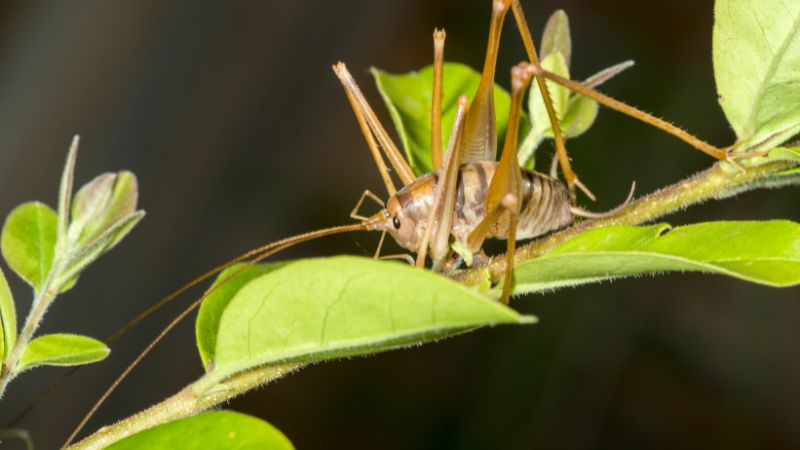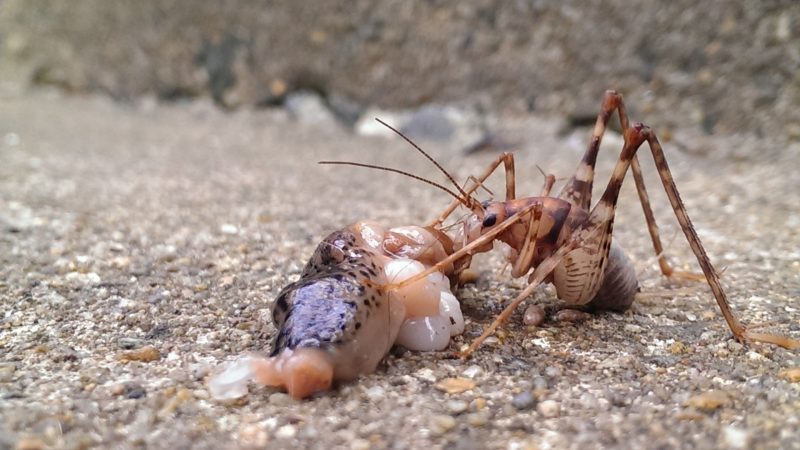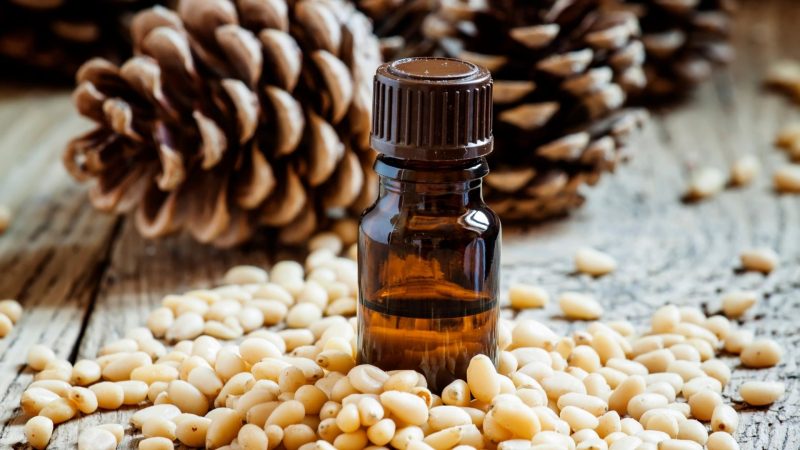If you have encountered an insect with a somewhat arched and prominent back, you have probably seen a camel cricket. They are also referred to as cave crickets, land shrimps, and sand treaders as these species are usually found in dune forests, wells, damp and cool places, deciduous forests, under rocks and logs, and within caves.
Are camel crickets dangerous? Camel crickets are not dangerous to humans, as they do not bite. They are not poisonous creatures and do not transmit diseases, bacteria, and other infectious microorganisms. However, they can be a nuisance in homes as they are known to be destructive of fabrics, clothing, curtains, and even house plants.
Now that you have learned that camel crickets are not dangerous, let us know more about these humpbacked creatures by exploring their nature, identifying characteristics, traits, behaviors, and the effective measures in controlling and getting rid of them.
What Is a Camel Cricket?

Camel crickets (Rhaphidophoridae) are present in almost all of the regions of the world, with over 100 species of them in the United States and Canada alone. They are active during the night and depend primarily on their sense of touch. Unlike other crickets, they don’t grow wings.
These insects prefer to live in damp, moist, and cool locations and are regarded as a nuisance in homes due to their capability to cause damage to properties.
In terms of appearance, crickets have light tan to brownish bodies that reach up to 2 inches in length. They have long legs, drumstick-shaped thigh parts, length antennae, humped backs, and slightly downcast heads.
How Many Eggs Do Camel Crickets Lay?
The female camel crickets can lay 2 to 5 eggs in a single site, with over 30 eggs in total at different locations. Before the said eggs are laid, they would bury their abdomen under the soil or sand until the eggs go out from their bodies.
Are Camel Crickets Spiders?
Camel crickets are not spiders. They are not considered arachnids, although they may look like them due to their long hind legs. However, camel crickets only have 6 legs compared to spiders, which have 8.
Related: Are Crickets and Grasshoppers Related in Any Way? | All You Need to Know!
What Are Camel Crickets Attracted To?
Camel crickets are greatly attracted to damp, moist and humid places. They have a fascination for locations with a high degree of humidity and moisture as they love extreme weather conditions.
Thus, they are commonly found in bathrooms, laundry areas, basements, utility rooms, attics, garages, drainage pipes, crawlspaces, under sheds, and other parts of the house or building where dampness is prevalent.
When they are outdoors, they also prefer humid areas like under stones, mulch, woodpiles, debris, and railroad ties.
What Do Camel Crickets Eat?

Camel crickets eat organic matters such as fungi, fruits, tubers, roots, mushrooms, and flowers, including decaying organic materials. They are also omnivorous insects, as they eat plant matter.
Other than that, they have a diverse range of food preferences as they can also feed on carpets, cardboards, wood, fabrics, and insects, including those of their own kind in some cases.
What Does Camel Cricket Poop Look Like?
The droppings of crickets are black and round that appear like poppy grains, although smaller. They are usually seen in a scattered manner and dries very fast due to their tiny size.
Why Do Camel Crickets Jump at You?
This indicates that they are probably startled and threatened. As their defense mechanism, they jump and leap at certain heights. This is their method of scaring their predators and escaping from their natural enemies. They usually use their long hind legs in order to flee from a dangerous situation.
Do Camel Crickets Bite?
No, since they lack the proper set of fangs and teeth that can cause punctures on the skin. Their mouthparts are primarily designed for chewing food. Therefore, it can be said that camel crickets are harmless as they do not bite and transmit diseases to humans.
Can Camel Crickets Climb Walls?
Yes, they can walk on vertical surfaces, especially when trying to enter the gaps, openings, and holes of houses and other fixed structures. Generally, their method of movement is jumping, crawling, and climbing with the use of their extensive hind legs.
How to Kill Camel Crickets Naturally?

If you want to kill camel crickets naturally, you may use the following materials:
Diatomaceous Earth
This is an all-natural product that contains minuscule diatom fossils that can lacerate and slice the camel cricket’s exoskeleton when ingested. It punctures their body structures, causing them to become dehydrated and eventually die.
Peppermint Oil
When combined with white vinegar, it becomes more potent in getting rid of camel crickets. This can be done by making a solution made from peppermint oil, water, and white vinegar and using it as a spray in areas where they are abundant.
Boric Acid
This is an important household or laundry essential that can also help in deterring a wide variety of insects, including camel crickets. You can use it as a spray against them by mixing the said substance with equal parts of water.
Neem Oil
When ingested, this substance can disrupt the insect’s physiologic functions by altering their hormonal process, causing them not to eat, drink and reproduce. This can also result in their subsequent death.
Cedar Oil
This substance is not only fragrant but can also kill insects such as camel crickets. It works by causing their bodies to dehydrate and inducing their fats to emulsify, thereby leading to their eventual demise.
Related: Home Remedies for Cricket Control: How To Get Rid of Crickets Naturally?
Getting Rid of Camel Crickets in Particular Areas
How to Get Rid of Camel Crickets in Basement?
These are the best strategies in battling camel crickets in basements:
- Seal the gaps, cracks, and other openings where camel crickets can potentially enter. Fix and repair the leaks inside the basement, if there are any.
- Reduce the moisture levels of your basement by transforming it into a waterproof territory or utilizing a dehumidifier to drop off the moisture level of the said place.
- Use sticky traps to catch and seize camel crickets. This can be done by employing homemade materials like duct tape and food ingredients as bait. However, you can buy ready-made insect traps that can be bought in stores and markets for purposes of convenience.
- Put several containers of water and soap solution in the basement as camel crickets are greatly attracted to water and moisture. Once they dive in the said mixture, they will drown and eventually die.
- Get the assistance of natural enemies like cats, mice, or chameleons. These creatures can help hunt down and devour several insects, such as camel crickets.
How to Get Rid of Camel Crickets in Garage?
If you want to get rid of camel crickets in the garage, just follow these helpful steps:
- Step 1: Inspect your garage for the presence of a camel cricket infestation.
- Step 2: Reduce the moisture level of your garage by keeping it dry or using a dehumidifier.
- Step 3: Spray insecticides in areas where they are seen breeding or around the garage area to make an insect barrier.
- Step 4: Place camel cricket traps in areas where they can potentially enter or stay.
- Step 5: Do not stack or pile boxes and other stuff near the walls of the garage in order not to block the airflow. This is also to monitor the area for the presence of insect pests easily.
- Step 6: Regularly clean your garage in order to lessen the clutter that may be used as a camel cricket’s food source.
How to Get Rid of Camel Crickets in House?
If your house is being infested with camel crickets, you may opt to employ the following measures:
- Assess the degree or severity of camel cricket infestation. Inspect the areas of your house where these insects can possibly invade and enter.
- Once you discover holes, gaps, cracks, and openings inside your house, seal it using caulks, seals, or plasters. This may be used as the camel cricket’s point of entry. Make sure that the doors, vents, and windows fit tightly when closed.
- Apply polyurethane insulating foam around dryer vents, entry spaces of plumbing and wiring sites, and window frames of basements.
- Use a vacuum cleaner or sticky traps in capturing and catching camel crickets inside your house. Apply insecticides in crevices and openings where camel crickets are known to be hiding. You can also incorporate it in a food bait.
- Utilize a dehumidifier or fan to minimize the moisture level of your indoor spaces.
- Organize and pile the boxes, objects, papers, and other unnecessary supplies inside your house to lessen their hiding areas.
- Always exercise proper sanitation and cleaning practices. Remove and clean any unwanted wastes and clutter that may be found indoors. These things might be used as camel cricket’s food.
How to Get Rid of Camel Crickets Outside?
If your camel cricket problem is found outdoors, it may be helpful to apply the following techniques:
- Use insecticides in creating a residual barrier outside of your house.
- Do not place bricks, firewood, and other woodpiles, brushes, and other objects near the outdoor walls of your house.
- Mow the lawns and grounds regularly. Trim or remove, if possible, tall grasses, shrubs, ground covers, mulch, and weeds near the said walls.
- Turn off your outdoor lights when not in use or replace the white, mercury vapor, or neon lights with less-bright yellow ones. This is due to the fact that camel crickets are greatly attracted to bright lights.
- Regularly clean and sanitize your outdoor surroundings. Clean and elevate your garbage receptacles using bricks or cement blocks in order to reduce the hiding spots of camel crickets.
How to Keep Camel Crickets Away?

If you desire to keep the camel crickets away from the perimeters of your house, it is advisable to follow these beneficial tips:
- Lessen the moisture level of your area by keeping it reasonably dry or with the use of fans and dehumidifiers.
- Use camel cricket repellents such as neem oil, peppermint oil, and cedar oil. You can mix it with water and spray it in areas where they are probably staying or hiding.
- Organize the boxes, papers, and other objects properly in order to minimize the hiding places of camel crickets.
- Remove the clutter inside or outside your area to deprive the insects of potential food sources.
How to Control Camel Crickets?
Controlling these crickets may be done naturally or through commercial and chemical means. If you prefer the natural methods for camel cricket control, you may opt to use organic materials like cedar oil, peppermint oil, and neem oil.
Additionally, you can choose natural control practices, such as regular cleaning and sanitation or moisture reduction. It can be employed to amplify the regulation of camel cricket infestation.
However, if you want faster results and convenience, the best thing to do is to purchase commercial insecticides, traps, and baits that can effectively deter, control and capture camel crickets. These items contain potent chemicals and substances that can be very adept in getting rid of insect pests.
The best examples include the following:
- READY TO USE: Cricket XL Giant Glue Traps are pre-scented and are...
- MAXIMUM PROTECTION: Catchmaster glue traps are safe, non-toxic...
- HOME & FAMILY SAFE: Designed to help you keep your family...
- TOTAL COVERAGE: The indoor bug catcher can be used in...
- INTELLIGENT PEST MANAGEMENT: At our core, we are dedicated pest...
- Weather resistant
- Target pests: Ants, Cockroaches, Crickets, Earwigs, Silverfish,...
- Minimizes call backs
- 5% Boric Acid active ingredient
- Indoor / outdoor use
- Long Lasting - Traps crickets for weeks at a time
- Easy to Use - Simply fold the trap and insert the tab at the top...
- Discreet - Slides easily under furniture and bedding
- Versatile - For residential and commercial use
- 2 Traps - Two large traps included in each package
- Glue traps for crawling, jumping, slithering pests
- Scented glue attracts insects, crickets & spiders, Pre-baited...
- Made in USA by JT Eaton, pest experts since 1932
- Adhesive works in variety of temps, even in cold: Non-drying,...
- Each Trap: 10”L x 2.5”W
Here is a video on how effective and quickly a glue trap works:
Do Camel Crickets Die in the Winter?
No, they don’t. During winter, they would hide in warm places, usually in spaces under stones, logs, tree barks, haystacks, or within caves and holes in the ground.
Additionally, they may also go inside homes and establishments through the openings, cracks, and gaps to escape from the freezing temperatures outside. This is when they become nuisance pests.
In the cold climate, they would mate with other crickets and lay their eggs after some time. They will also try to slow down their metabolic processes and conserve their energies.
Summary
Camel crickets are flightless creatures with light tan to brownish bodies and long hind legs. They somewhat appear like spiders, but they are not part of the class Arachnida. Camel crickets are not dangerous creatures as they do not typically bite humans nor transmit illnesses and diseases to them. However, they can damage household properties such as curtains, fabrics, and pieces of clothing. Thus, there is still a need to control and get rid of them.
Related: Cave Cricket Control: How to Get Rid of Cave Crickets?
List of Sources
Breisch, N., & Thorne, B. (2020). Cricket.
Iowa State University. (n.d.). Camel Cricket.
Miner, A. (n.d.). Black-Sided Camel Cricket – Ceuthophilus Latens.
Zungoli, P., & Benson, E. (1999). Home & Garden Information Center: Camel Crickets.
- How to Get Rid of Cockroaches? | Proven Strategies & Solutions! - June 24, 2023
- Powerful Homemade Wasp and Bee Sprays (with Recipes) - March 4, 2023
- Crazy Ants Invasion | Eradicate & Prevent Unwanted Guests - February 24, 2023




